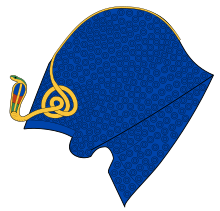Egyptian royal headdress From Wikipedia, the free encyclopedia
The khepresh (ḫprš) was an ancient Egyptian royal headdress. It is also known as the blue crown or war crown. New Kingdom pharaohs are often depicted wearing it in battle, but it was also frequently worn in ceremonies.[1] While it was once called the war crown by many, modern historians refrain from characterizing it thus.[2]
| Khepresh | |
|---|---|
 Khepresh, the blue crown of Egypt | |
| Details | |
| Country | Ancient Egypt (New Kingdom) |
No original example of a khepresh has yet been found. Based on ancient artistic representations, some Egyptologists have speculated that the khepresh was made of leather or stiffened cloth[3] covered with a precise arrangement of hundreds of sequins, discs, bosses, or rings. Given that the deshret (red crown) and hedjet (white crown) were apparently woven of some sort of plant fiber, the circles or rings decorating ancient artistic representations of the khepresh may instead indicate the regular array of hexagonal holes in an open triaxial weave. As with many other royal crowns, a uraeus (cobra) was hooked to the front of the khepresh.
| Blue Crown "War Crown" in hieroglyphs | ||
|---|---|---|
The Blue Crown, or War Crown, was represented in hieroglyphs.
The earliest known mention of the khepresh is on the stela Cairo JE 59635 [CG 20799] which dates to the reign of pharaoh Neferhotep III, during the Second Intermediate Period.[4] In this and other examples from the same era, the word is written with a determinative that represents the cap crown, a lower and less elaborate type of crown.
The earliest known depiction of the khepresh is on the stela Cairo CG 20517 which dates to the reign of Snaaib, during the Second Intermediate Period. The stela shows him wearing the Khepresh crown and adoring the god Min[5][6]
During the New Kingdom, pharaohs were shown with this crown in military circumstances. However, some scholars think that the crown was also meant to evoke the divine power of the pharaoh, and was thereby worn to religiously situate kings as manifestations of gods on earth.[7]
Images of the khepresh from the reign of Ahmose I, first king of the Eighteenth Dynasty, show a headdress that is taller than the cap crown and more angular than later forms of the khepresh. This crown continued to evolve during the early Eighteenth Dynasty, attaining its best-known form in the reigns of Hatshepsut and Thutmose III.[8] After Amenhotep III's reign – and particularly during the 18th and 19th Dynasties – it came into fashion and was even adopted by some pharaohs as a primary crown.[9]
The crown was not seen depicted in the Kushite Dynasty (747 to 656 BCE).[10] However, depictions of the crowns returned in the Twenty-sixth Dynasty of Egypt. Some of the early Roman pharaohs are also depicted wearing it.
Seamless Wikipedia browsing. On steroids.